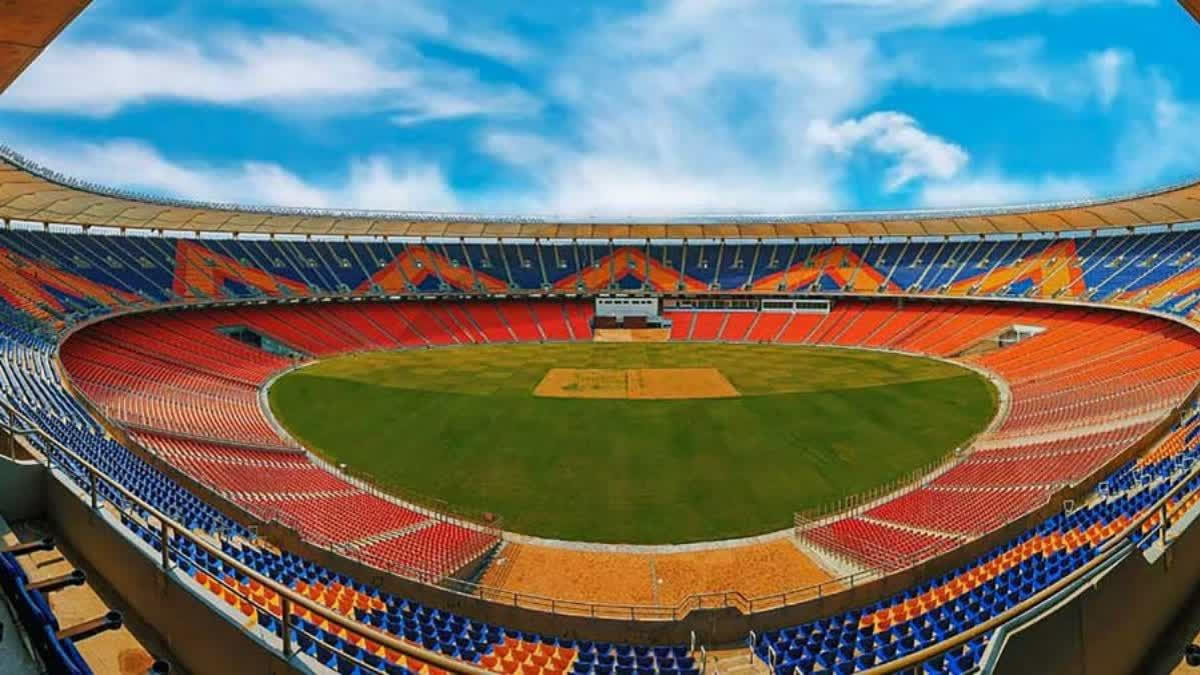Ahmedabad (Gujarat): Motera, the small suburb of Ahmedabad in Gujarat, will be the cynosure of all eyes across the globe when India meets Pakistan in this 1,32,000-capacity bullring, the largest cricketing stadium in the world.
Its bigness of being will complement the occasion that it has engineered – a high-tension match between eternal rivals India and Pakistan, on a hot territory that has long been politically charged and carries more chirp than just about cricket.
Though tension is always high among players when they meet their cross-border competitors, this time, Narendra Modi stadium in Motera will up the ante for both teams – India with the spectre of losing, and Pakistan with the fear of playing India in Gujarat for the first time in a long while, that too with 1,32,000 spectators breaking the sound barrier, mostly in support of the hosts.
Then there is the security nightmare which has been keeping the entire police department on its toes. Managing 1,32,000 spectators charged to their gills and chanting for India in the largest sports stadium in the world may be that perfect point to showcase the World Cup. But, on a more realistic level, the thriller will be fraught with possibilities.
Before the Modi eye came on to this sporting facility, Motera was, much like Multan, known to be a heat and dust speck on the venue map of cricket, with possibly the most uncomfortable press box in India, if Delhi press box’s odd positioning is ignored. However, the milestones have been degrees higher here.
It has sported big occasions right from that hot and dusty day on March 7, 1987, when Sunil Gavaskar became the first batsman to breach the 10,000-Test run mark at this venue, then called the 'Sardar Patel Stadium'. This was a feat that no great, not even Don Bradman, had reached.
The poetic beauty was that Gavaskar scored those reality-altering runs against arch-rivals Pakistan who, incidentally, had India in a corner with 395 runs scored. Kapil Dev, too, has a 1994 Motera feather in his cap. It was here that he surpassed Sir Richard Hadlee’s long-held record of being the highest wicket-taker in Test cricket. It was here that he took his 432nd scalp as an equal number of balloons went up into the sky and spectators stood and clapped for five minutes on the trot.
The Sri Lankans, playing this crucial match, joined in the celebration. Kapil’s nine wickets for just 83 runs in the inaugural international match at this stadium in 1983 against West Indies, continues to be a worthy mention in cricket folklore.
Yes, the heat at Motera has been unrelenting with the sun pouring down straight at your head. Such are the environs here that journalists covering anything in Motera at any point of time through the year are advised to wear hats or suffer heatstroke. But that hasn’t been able to contain the growing stature of this stadium where low scorers add tension to the proceedings with the pitch being in a rigid frame of mind all through the day and night.
The refurbished facility sits grandly today on a spend of close to Rs 800 crore, club area, eateries, a massive stands expansion and a name change that goes all the way up to India’s highest seat of power – Prime Minister Narendra Modi. It took Motera five years from 2015 to 2020 to gain area, aura and stature not just for the 'Amdavadis' but for the nation which now boasts of having the biggest cricket coliseum in the world.
On an L&T construct and Tata Steel in its pillars of strength, the ornament next to the historical Sabarmati is all glitter and gold. From hosting the Indian Premier League final last year under the skippership of none other than Hardik Pandya, to stopping the marauding Australians from getting into the semifinals of the 2011 World Cup, Motera has been in business for a long time.
This year, it has not just wrested the laurels of a final of the World Cup from the old soldier of cricket, the sea-kissing Wankhede Stadium in Mumbai, but also the reputation of being bigger than Eden Garden could ever envisage to be, infrastructurally marvellous and politically agile as Modi’s apple of the eye.
Also read: Cricket World Cup 2023: Ishan Kishan can play at any spot and perform well, reckons his father



